I realize I haven’t posted in a while, mostly because I’ve been lazy and haven’t been cooking much that’s interesting — and I haven’t been bringing my camera to restaurants either, sorry to say. But this is Thanksgiving, so it’s time for a good old-fashioned meal.
Unfortunately, I dislike turkey, and what’s more I don’t have an oven to roast it in anyway. So I decided to do old-fashioned Japanese-style late autumn food, with a Thanksgiving twist.
For the bird, duck, which is a big deal in Kyoto. The main river here is the Kamogawa, which means Duck River, so you can already tell they’re into this. Mashed squash, which around here is kabocha. For a sweet-and-sour fruit thing, à la cranberry sauce, I found a nice-looking recipe for a persimmon with vinegared fruit and vegetables inside. And then, because it’s Japan, I figured I’d do some soy-glazed sardines (the fresh kind, not the ones in cans).
Miso
Now the first step was to get some miso. The recipe I had for duck involves grilling duck in a complex miso glaze on top of a magnolia leaf — a very old-fashioned preparation called hoba-yaki (hoba means “magnolia leaf,” and yaki means “grilled”). But the recipe was also pretty specific about which misos to use, and that meant a little hike.
Acting on a tip from the Kyoto Foodies, I hiked up to Honda Miso (no relation to the cars, I think), which is at Muromachi-Ichijo, just southwest of Karasuma-Imadegawa, for those in town. As you can see, I had something of an embarrassment of riches here: too much to choose. Fortunately I knew what I wanted, and asked, and was handed three packages of miso: white Saikyo miso, near-black sakura miso, and a red-brown kōji miso.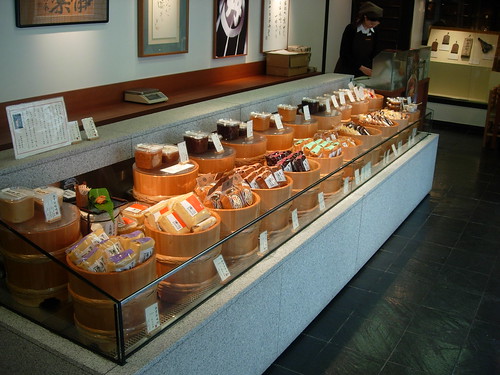
I now have nine kinds of miso in my fridge, and must start experimenting rather more vigorously or I’ll never get through it all.
Nishiki
Then it’s off to Nishiki Market to get the rest. Clockwise from the top right golden box: sake, katsuo bushi (fresh-shaved bonito flakes), negi scallion-leek, yuzu (yellow at this time of year), mitsuba, daikon, red carrot (a big deal locally), ginger, sesame seeds, sliced inexpensive matsutake mushrooms, duck breast, sardines (in the bag), chestnuts (below the sardines), persimmons, half a kabocha squash, magnolia leaves (in the very back).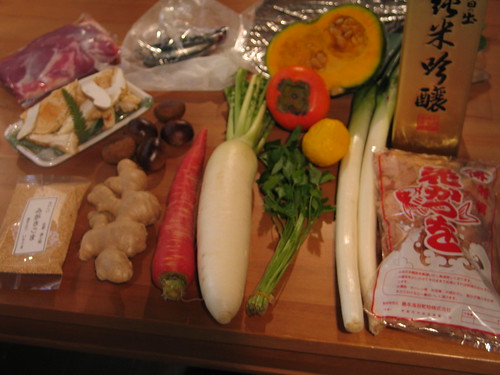
The magnolia leaves were tricky, but fun. I asked at every vegetable stand, and was told they didn’t have it. At one place, a guy about my age didn’t even know what this was, and I explained it was for hoba yaki (or hoba miso), and he still didn’t understand. He was about to start apologizing politely to the nice foreigner who’s using bad Japanese and terms that don’t mean anything, but then his father steps in. I couldn’t follow all of it, between my minimal Japanese and the thick Kyoto accent of the father, but it was pretty clear:
Father: He wants hoba leaves, for hoba yaki.
Son: What are you talking about?
Father: You’ve never had hoba yaki?
Son: Um, no, what is it?
Father: You’ve never had hoba yaki? What the hell?
Son: Dad, what are you on about?
Father: I can’t believe you’ve never had hoba yaki! I mean, no, we don’t have the leaves, but it’s a great idea for a day like this, and you’ve never even had it? I can’t believe it.
Son: Oy ve, here we go again.
Okay, something like that.
Eventually I go to yet another place and ask, and the dour-faced woman says something totally incomprehensible to me. I apologize. Impatiently, she repeats it, slowly. I apologize. She stalks to the back, argues with an old man (her husband?), and disappears. She returns with a flat package containing 10 frozen magnolia leaves. Now it’s clear: she’s saying that (a) they’re frozen, and (b) they come 10 to a package, and is that okay? I agree, sweating a little, because I’m worried this is going to cost me. Still irritated, she demands the money: 500 yen. $5 and change. Er, okay lady, sure. $5? Hell yes. I pay and depart, still wondering what her problem is. Oh well.
The duck was pricey. Everything else was pretty cheap. So all in all, it came out fine.
Oh, and all that miso? $15 even.
Making Dinner
So after picking up Sam at nursery school and waiting interminably for a late bus, I’m a little behind and have to work quick and clean. I also ding myself on the corner of my petty knife, which is annoying because (a) it slows me down and (b) it’s so sharp that the cut bleeds like hell. I ask Sam to get me some toilet paper to wrap around it after I wash, because every time I lift my hand it’s dripping blood, and he very slowly and carefully gets me two sheets. One of them ripped in half. Can you spare it, kid? Anyway, I manage.
The slow stuff at the start I photographed assiduously, and I was planning to keep doing it right through the meal. But then crunch-time hit, the kids were being bonkers, and photos stopped happening. I don’t know how other food-bloggers do it. Do they make everything in advance? Or just make one dish at a time? Or do they get a friend or spouse or somebody to take photos while they’re cooking? If I’ve got three burners going and am cutting and finishing all at once, photos are just not on the cards. Still I’ve got something for show-and-tell.
The first thing after making dashi was to make tosa-zu, which is a special kind of vinegar for light pickling dishes. Unlike regular vinegar, you’ll be happy to eat this. Basically what you do is you mix vinegar, soy, sugar, and dashi, heat it almost to a boil, and then throw in katsuo bushi flakes and shut off the heat. When it’s cool, you strain it. It tastes fabulous, I don’t know why.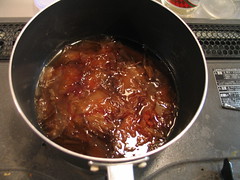

Next, I peeled and diced my half-kabocha, which incidentally is not a small thing to do. Raw kabocha is so hard that if you cut it with a traditional Japanese vegetable knife, you can break the blade. So you use a big honking thing called a deba, which fortunately I have. But it’s still work. I heaved this in a big pot, covered it with water, and left it alone for later, when I boiled it until very tender, drained, mashed the hell out of it, added... well, I’ll get back to that.
I cut nice even rectangles of red carrot (a local specialty) and daikon radish, and dropped them in a bowl of very salty water to pickle lightly for later.
I also put my cleaned sardines in salt water for later, to draw out the fishiness.
Then I blanched the mitsuba and cut the stems in 1.5 cm lengths.
And I peeled and simmered the chestnuts. Now this turned out to be much more irritating than I’d expected. I knew that Julia Child says to cut off a 1/8-inch strip of the shell, drop them in cold water, bring to a rapid boil, boil 1 minute, and then dip them out and shell. Sure, but the inner shell doesn’t come off for love or money. I found in the end that the best way is to shave it off with a very sharp little knife. (No, this isn’t how I cut myself.) But it took a while. Then I dropped them in a simmering liquid and started simmering. I cooked them 15 minutes, found them hard, and needed the burner. So I put them in the microwave in the liquid and nuked them on low power for 15 minutes, covered. Later on, it turned out they were still rather hard for my taste. Then again, I don’t much like chestnuts to begin with. Oh well.
After that, crunch time came, so no more photos till the end. Here’s what happened, more or less simultaneously:
1. Score the duck skin in a diamond pattern and cook gently over medium heat, skin down, until just golden, rendering out most of the excess fat. Put the duck to one side, and the fat to another.
2. Boil the hell out of the kabocha, 25 minutes, until super-tender, then drain and mash with butter, fatty milk, and the rendered duck fat (yum!).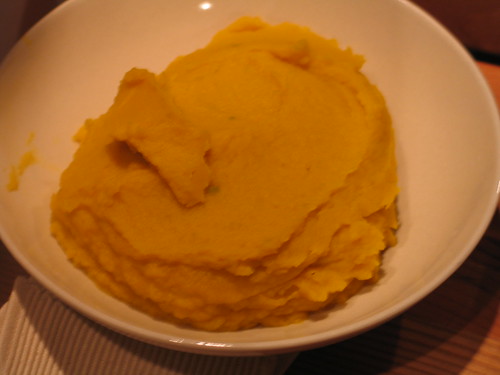
3. Mix up a combination of sakura miso, Saikyo white miso, sake, egg yolk, and sesame paste, and cook it over low heat, stirring constantly, for 15 minutes, until quite thick. Reserve.
4. Slice the duck on the bias and keep aside.
5. Soak two magnolia leaves.
6. Hollow out 3 persimmons, discover that they’re a bit unripe and full of hard seeds, peel and slice a fourth in neat rectangles. Put these rectangles, the mitsuba stem pieces, and the drained carrot and daikon rectangles in a mixture of the tosa-zu, fresh-ground sesame seeds, mirin sweet cooking wine, and soy. Let soak a while, then portion into the hollowed-out persimmons.
7. Put the sardines in a little hot oil to brown on one side along with a lot of sliced ginger, then turn over, cook briefly, and add half a cup of cheap sake. Put a lid over it sitting on the bottom of the pan, cook until the sake is reduced by half, then add a few Tb soy sauce and cook uncovered until the sauce is thick and sticky. Put the sardines on a plate and pour the sauce and ginger over the top. (I got this recipe from the Kyoto Foodies again.)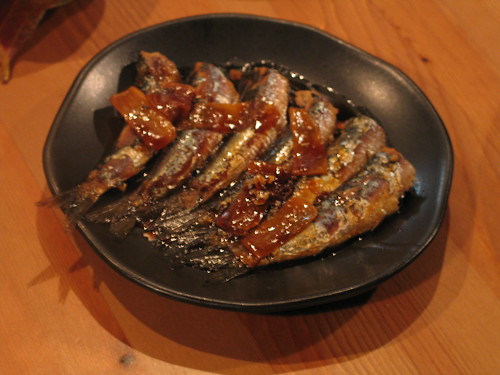
8. Put a soaked magnolia leaf on my brilliant wire-mesh grill thingy, cover with a big dollop of the miso mixture, add a couple of chestnuts, and top with several slices of duck and a pinch of julienned negi scallion white. Turn on the burner and wait.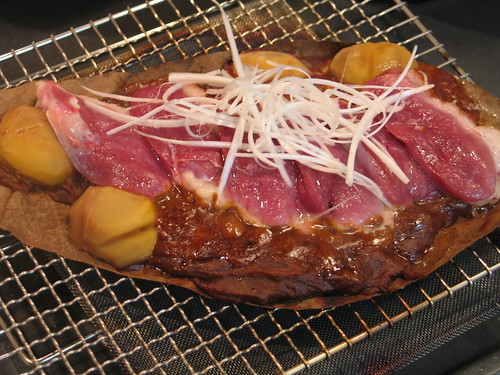
9. Cut carrot and onion fine, cook with butter, add half the matsutake cut in small chunks, cook until browning, add a bunch of water, cook until thickening, add the remaining matsutake, cook until just done, season to taste, serve.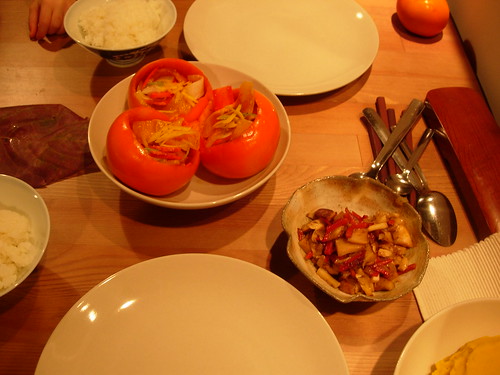
So there you have it: Thanksgiving dinner.
The Results — The Envelope Please...
The persimmon thing was spectacular. Also easy. I will do this again. My wife had two and could have had more.
The mushrooms were lovely: fragrant, tender, and just right. A quiet, mild dish that I thought sat nicely next to exciting things like the persimmon and duck.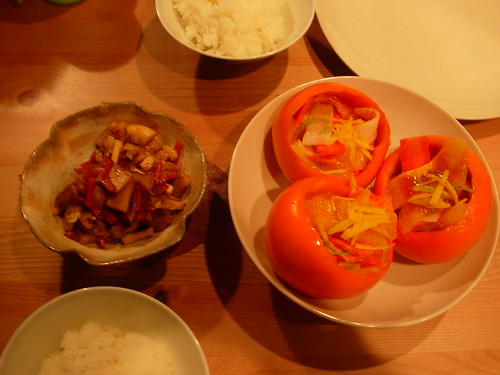
The duck thing is excellent, but tricky. You’re supposed to cook it on a grill that sits at the table, which I don’t have, and when you move the leaf the miso thickens unpleasantly. The duck has to be absolutely paper-thin, too, or it overcooks on one side while remaining blood-rare on the other. This technique is very simple, but it’s not as simple as it looks. I will experiment with it, without the duck, until I get it right: just mushrooms and miso is pretty wonderful. The thing is, the miso gets this roasted, smoky taste going on, and also it caramelizes a bit. I still don’t like chestnuts very much, despite the effort, and I won’t put that effort in again.
The sardine thing is very good, but overpowered by everything else here. I’d do it again, though, especially given how cheap it was (200 yen for 6 sardines is pretty impressively cheap). No, that's not a magnolia leaf as far as I know, it's just something Sam decided he had to bring home from nursery school.
The mashed squash was lovely but rather bland. But that was the point, after all. The hint of duck from the fat was certainly a good thing, but it was mostly a kind of background minor dish.
Dessert was supposed to be cake, which I bought and had on hand, but everybody was far too full, so we’ll have it tomorrow.




4 comments:
This looks like pretty exciting ingredients to get to work with...I love the idea of the different miso, since you only get a few choices here in NJ.
Oh, the range of exciting ingredients here! Many of them are bog-standard to the locals, of course, but they're not like that for me. One of these days I'll do a post about nothing but ingredients.
The thing about miso, though, is that you should really look around. Try New York, if you get up there much. It keeps more or less forever so long as you put it in the fridge, keep a piece of plastic or wax paper pressed to the surface, and keep a lid on. As long as it's not furry or gray, dig in. So if you find something you haven't seen before, pick it up: it won't go bad.
Just remember that the coarse kinds are almost never used in soup. (Except when they are, of course. Isn't that helpful? No, but honestly, they leave funny chunks in the bottom.)
Hello Chris,
Sorry to not stop by your site recently. It is coming right along and I am glad to see that you are living it up in Kyoto!
You did magnolia leaf with duck AND chestnuts. That is pretty zeitaku -- nice! I haven't had miso on the leaf for a few years now, you have inspired me to whip some up tonight.
Glad you liked Honda miso, nine kinds in the fridge also sounds nicely zeitaku. I think I only have two, maybe three in mine now. Boo hoo.
Please stop in at 'Kyoto Support' forum and share your insight regarding miso. All your other insight would be welcome too, of course!
Where to Purchase Basic Ingredients for Japanese Cooking in Kyoto
Where to Purchase Condiments, Sauces and Spices in Kyoto
Take care.
P
"Can you spare it, kid?"
This slays me. Way to live it up.
Post a Comment